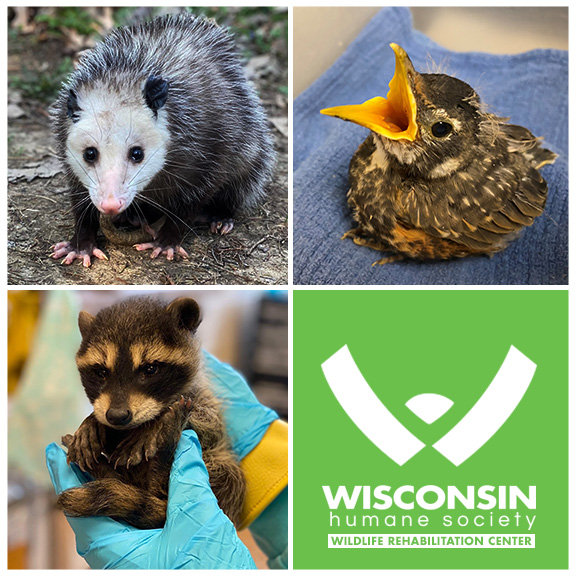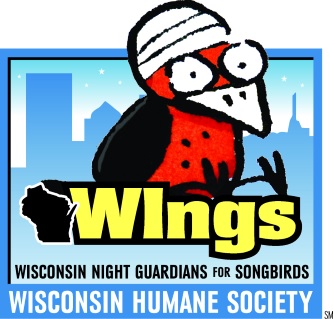Sick or Injured Mammals
CLICK HERE for a print-friendly version and visual instructions!
Situation: You've found a mammal that you think may be sick or injured.
Why this happens: Mammals can become sick or injured for a variety of reasons, including being hit by a car, cathcing a disease, falling into a window well, or getting stuck in a fence.
FAQs and Humane Solutions
"I found a mammal that I think is sick or injured. What should I do?"
If you find a mammal that you think might be sick or injured, ideally you should contact your local licensed wildlife rehabilitator for advice BEFORE attempting to capture the animal. In Milwaukee County, you may call us at the WHS Wildlife Rehabilitation Center at (414) 431-6204. If you are from outside of Milwaukee County, please contact a licensed wildlife rehabilitator in your area. To find a licensed wildlife rehabilitator, call your nearest Wisconsin Department of Natural Resources Service Center.
To prevent the animal from crawling away or becoming further injured while you are calling for advice, you can cover the animal with an empty, overturned plastic bin, garbage can or box. Protect yourself from being scratched or bitten by not trying to touch the animal directly. If the rehabilitator feels the animal should be brought in to them for care, they should explain how you can safely contain the animal for transport. This will help protect you from being scratched or bitten and will help protect the animal from further distress caused by improper capture methods.
Generally speaking:
- Do not provide the animal with any food or water unless you are told to do so by the wildlife rehabilitator
- Cottontail rabbits almost never bite, but opossums, raccoons, woodchucks, squirrels and many other types of mammals may bite to try to protect themselves if someone tries to handle them. Therefore, do not handle the animal directly, even with gloved hands. It is much safer to scop the animal up using a box or plastic storage bin, or use a shovel or broom to gently guide or scoop it into a container.
- If you've already contained the animal under a box or similar container for transport, you can GENTLY slide a stiff piece of cardboard, plastic or plywood between the ground and the animal without removing the overturned container. You'll ten need to secure the piece of cardboard, plastic or wood to the container to keep the animal from getting out. You can use duct tape, rope, wire, bungee cords, or cable ties to make sure the panel is secure. With the panel securely in place, you may find it easier to transport by slowly turning the container over so that it is now "right-side up."
- Ideally, the floor of the transport container should be covered with a newspaper or ravel-free cloth (no loose strings or loops, similar to a pillow case). Additionally, pencil-sized holes should be punched in the lid and/or sides (prior to containing the animal) to provide him or her with air, and the lid of the container should fit tightly.
- Keep the contained animal in a warm, dark, quiet place until it can be transported and received at the wildlife rehabilition center.
Caution: Be advised that gnawing mammals like squirrels and woodchucks may be able to chew their way out of a cardboard container; although if they are very sick or badly injured they will usually not try to escape. Furthermore, an adult raccoon or coyote - unless it is very sick or badly injured - may be able to push its way out of a container. If available, a plastic airline pet carrier is usually a better choice than a box or plastic bin for containing and transporting those speices.
''After I contain the animal, is there anything in particular I should or shouldn't do?"
Stressors such as loud noises, talking, excessive handling, or the close proximity of pets or people can create life-threatening stress for the animal. You should minimize stress by not playing your car radio during transport and by keeping talking and other noise to a minimum. Do not needlessly look in on the contained animal.
Do not give the animal food, water or medication unless you are directed to do so by a licensed wildlife rehabilitator.
Get the animal to a licensed wildlife rehabilitator AS SOON AS POSSIBLE. Once an animal is injured, the clock is ticking. The sooner an animal gets to a licensed wildlife rehabilitator for treatment, the better its chances for recovery. By law, you have 24 hours to get the animal to a licensed wildlife rehabilitator.
"I really want to help this animal I found, but I am uncomfortable or incapable of trying to capture him myself. Can you come rescue it for me?"
As a non-profit organization with limited resources and potentially as many as 500 animals in our wildlife hospital, we are not always able to to assist with picking up animals. We do have trained wildlife rescue volunteers that may be able to help if one is available. If you can't contain and transport the animal yourself, please try to enlist a family member, friend, or neighbor to help you.
If you absolutely can't contain or transport an animal, and you cannot find a friend or neighbor to help you, by all means give us a call! If you are in Milwaukee County, we'll do our best to get help for the animal you've found. If you are outside of Milwaukee County, you may call a WI DNR Service Center for help in finding a licensed wildlife rehabilitator, or call us at (414) 431-6204 and we can assist you over the phone and help direct you to a licensed wildlife rehabilitator in your area.



